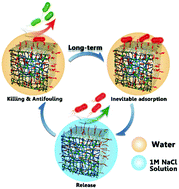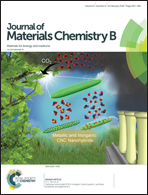Integration of antifouling and antibacterial properties in salt-responsive hydrogels with surface regeneration capacity†
Abstract
The development of new antimicrobial materials and strategies is of importance for many biomedical and industrial applications. In this work, we report a new strategy to integrate distinct antimicrobial, antifouling, and stimuli-responsive properties into a single hydrogel to realize bacteria resistance, killing, and releasing functions. To achieve this design, we conjugated salt-responsive anti-polyelectrolyte polyDVBAPS (poly(3-(dimethyl(4-vinylbenzyl)ammonio)propyl sulfonate)) with antifouling polyHEAA (poly(N-hydroxyethyl acrylamide)) and antimicrobial AgNPs (silver nanoparticles) to form a hybrid hydrogel of polyDVBAPS-g-polyHEAA@AgNPs, among which polyHEAA functions as a general antifouling background to prevent bacteria adsorption on the surface, AgNPs act as antimicrobial agents to kill bacteria on the surface, and polyDVBAPS uses its unique salt-responsive, anti-polyelectrolyte property to release adherent bacteria from the surface. In this design, polyDVBAPS-g-polyHEAA@AgNPs hydrogels not only effectively resist bacteria attachment and kill the adherent bacteria, but also regenerate the antifouling surface of the hydrogel by releasing the adhered bacteria to keep the surface free from bacteria. The polyDVBAPS-g-polyHEAA@AgNPs hydrogels exhibited high surface resistance to bacteria adsorption (<106 cells per cm2) for up to 4 days, high antibacterial activity by killing ∼99% of attached bacteria of both E. coli and S. aureus, and surface regeneration ability by releasing >96% of adherent live or dead bacteria from the surface upon a simple treatment of 1.0 M NaCl solution for 10 min. Upon the release of AgNPs, AgNPs were reloaded into the hydrogel again to achieve multiple antifouling, bactericidal, and regenerative properties. This work demonstrates a new design for a new multifunctional hydrogel to effectively achieve antimicrobial, antifouling, and surface regeneration properties, making this hydrogel very promising for antimicrobial applications.

- This article is part of the themed collection: 2018 Journal of Materials Chemistry B HOT Papers


 Please wait while we load your content...
Please wait while we load your content...